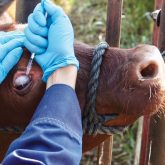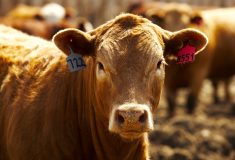roy lewis
dvm
As many of the pharmaceutical reps will tell us, at least we know the vaccine is working.
With more and more vaccines now given subcutaneously and especially with vaccines using oil-based adjuvant, reactions are not uncommon. The adjuvants are designed to protect the vaccine and give a much higher immune response but reactions in the form of lumps are an expected albeit undesirable result.
As many of the pharmaceutical reps will tell us, at least we know the vaccine is working. This is true and we must keep in mind before the same reaction was probably happening with the intramuscular products. It’s just the reactions happened deep in the muscle where it was not visible. This is where lots of the grisly scarring in the muscle cuts of meat would occur. So from a beef quality assurance standpoint there has been a huge improvement with almost all the vaccines going intramuscular.
Read Also

Pig transport stress costs pork sector
Popular livestock trailer designs also increase pig stress during transportation, hitting at meat quality, animal welfare and farm profit, Agriculture and Agri-Food Canada researcher says
Most of the lumps either regress with time or leave a small egg-sized lump called a granuloma, or basically a lump of scar tissue. You will find more reactions with the bacterins like blackleg and the other killed vaccines as they generally use the oil-based adjuvant. The modified live vaccines generally use sterile water as the liquid for reconstitution so the reaction is much milder.
More reactions can occur if nutritional status of the herd is low, especially in the three trace minerals copper, zinc and selenium. If there are a high percentage of large reactions nutrition should be checked as well as the producer’s administration technique.
Dull, bent, dirty or burred needles increase the likelihood of introducing infection or causing more trauma. This needs to be watched. Change needles when they are damaged, and every 10 or so animals. You can feel when they are getting dull and change them then. In my opinion the thick-walled steel needles with the cleaning wires should be outlawed as they give the producer the impression they can be cleaned and reused.
Avoid bad weather
If you are seeing large swellings from vaccination which subsequently abscess, technique is definitely in question. I have seen some wrecks vaccinating in the rain. The moisture seems to wash dirt into the needle hole or the process itself takes in more dirt, so try and avoid vaccinating in inclement weather. The infection starts after the vaccine is absorbed so in all likelihood there has been a response. Keep the vaccine protected from the elements as frozen or overheated vaccine will be ineffective and it might be denatured leading to more vaccine abscesses.
The egg-sized reactions are of no concern to the animal but are simply a blemish noticed more in the summer when the hair is slicked off. Purebreds, show or display animals can be vaccinated in places such as behind the elbow so if there is a reaction it won’t be noticed. Again, vaccinate in this location with the killed vaccines and bacterins.
I have never heard of these vaccine reactions being a problem on sale through an auction. The argument could be that at least you can see these particular stock are being vaccinated, which to me relates to good management. In the winter they become like a brand and disappear under the hair. When slaughtered these lumps are somewhat adhered to the hide and in almost all cases come off with the hind, not affecting the underlying meat in any way so there are no trim losses. We all know if they were a concern buyers would discount them on purchase and that is not the case or at least I have never heard of it.
MORE TIPS
Don’t vaccinate through manure.
If the multidose gun is hard to advance you may be too shallow and giving the vaccine intradermally (between the skin layers. You want to definitely give the product subcutaneously (under the skin) and it should be very easy to inject.
Use the smallest-gauge needle that still allows you to inject it quickly (16-18 gauge).
If the lumps get large (baseball size or larger) they most likely are abscessed and may need to be lanced and flushed.
To check technique, if giving several vaccines give them consistently in the same location leaving at least 10 or so centimetres between. Give on opposite sides of the neck if possible. That way if there are lumps you can assess which vaccine is involved or who had given the vaccine. Sometimes tweaking technique is all that is required.
Certain genetic lines of cattle are more reactive which is why certain producers will have a high incidence and other farms have almost no reactions with the same vaccine.
Cattle do not appear to get any more sensitive over time to repeated vaccinations but if reacted once, they commonly will react again, so you may see several of these same reactions.
Please accept vaccine reactions as a normal occurrence and investigate with your veterinarian if the incidence gets too high or if abscesses are created. Rest assured the vaccine is working and offering protection.
The future may see needle-less vaccination or oral or intranasal vaccines given.


















